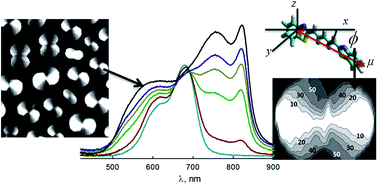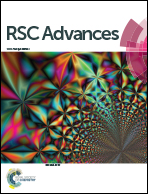Aggregation and structural study of the monolayers formed by an amphiphilic thiapentacarbocyanine†
Abstract
Exotic assemblies with unique photophysical features can be built based on organic dyes at the air–liquid interface. Langmuir monolayers of N,N′-dioctadecylthiapentacarbocyanine (OTCC) at air–water and air–solid interfaces have been studied. A single type of domain and presumably of one single aggregate type has been found by Brewster angle microscopy. Peanut-shaped domains with internal anisotropy have been observed. However, this structure leads to a complex absorption spectrum which shows 4 bands, two red-shifted (822 nm and 757 nm), and two blue-shifted (600 nm and 530 nm) with respect to the monomer band (665 nm). Our results confirm that all the absorption components are polarized in approximately the same direction. The absence of an emission spectrum indicates that this interfacial aggregate cannot be classified as a simple J-aggregate. Moreover, these bands cannot relate to Davydov splitting, given that all of them have the same polarization direction. We propose possible explanations based on a strong exciton–phonon interaction, and/or the formation of aggregates with different coherent lengths within the domain. The basic exciton model cannot explain this behavior. The coherent aggregate described in this study is proposed as a unique dye supramolecular structure obtained by assembly at the air–liquid interface.


 Please wait while we load your content...
Please wait while we load your content...